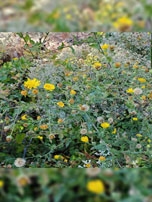SHAHEED KARTAR SINGH SARABHA AYURVEDIC MEDICAL COLLEGE & HOSPITAL
Affiliated to Guru Ravidas Ayurved University, Hoshiarpur Punjab
Affiliated to Guru Ravidas Ayurved University, Hoshiarpur Punjab

Botanical Name : Lactuca serriola – L.
Family : Asteraceae or Compositae
Introduction :
Lactuca serriola L. (Compositae) is an herbaceous species, known by several vernacular names, that is, Prickly lettuce, Jagged lettuce, Kahu and Khas. It is native to Himalaya, Siberia, and Atlantic areas but cultivated also in temperate lands of Europe, India, Pakistan, and Iran. The plant is used for multiple purposes in traditional medicines, like sedative, hypnotic, expectorant, cough suppressant, purgative, demulcent, diuretic, antiseptic, vasorelaxant, and antispasmodic and hence used to manage bronchitis, asthma, pertussis, gastrointestinal, and various other ailments. A brown viscid substance obtained following evaporation of the plant juice, called lactucarium, contains lactucone, lactucin, and lactucic acids. The plant contains vitamins, beta carotene, and iron. The phytochemical investigations of seeds revealed the presence of alkaloids, the bitter substance lettuce, oxalic acid, lactucopicrin, and sesquiterpene esters. The alkaloid, lactucin, isolated from the seeds, exhibited antipyretic activity, and a triterpenoid saponin isolated from stem possesses antibacterial activity. The pharmacological investigations on plant revealed its analgesic, anti-inflammatory, and antioxidant activities due to high total phenolic contents which showed efficient free radical scavenging potential like quercetin.
Although Lactuca serriola has traditionally been used to manage intestinal, respiratory, and vascular ailments, scientific investigations to validate such uses are so far lacking. The present study was undertaken to explore the pharmacological potential of 70% aqueous methanol extract of the plant and to study its possible mechanism(s) of action.
Names in different Indian languages :
English : China lettuce, prickly lettuce, wild lettuce
Sanskrit : Kakubha, Kahu
Synonyms :
Lactuca scariola L.
Morphology :
Lactuca serriola is a BIENNIAL growing to 1.5 m (5ft) by 0.3 m (1ft in).
It is in flower from July to September, and the seeds ripen from August to September. The species is hermaphrodite (has both male and female organs). The plant is self-fertile.
Suitable for: light (sandy) and medium (loamy) soils and prefers well-drained soil. Suitable pH: acid, neutral and basic (alkaline) soils. It cannot grow in the shade. It prefers moist soil.
Distribution & Habitat :
Waste places, walls, occasionally on more or less stable dunes
Prefers a light sandy loam in a sunny position
Parts Used :
Leaves.
Chemical Composition :
Acetylcholine chloride, atropine sulfate, carbachol, dicyclomine, dimethylsulfoxide, ethylenediamine tetraacetic acid, glucose
Uses :
Cardiac paralysis, Chronic catarrh, Cough, Swollen liver, Flatulence, Urinary tract infection, Ailments.
The whole plant is rich in a milky sap that flows freely from any wounds. This hardens and dries when in contact with the air. The sap contains ‘lactucarium’, which is used in medicine for its anodyne, antispasmodic, digestive, diuretic, hypnotic, narcotic and sedative properties. Lactucarium has the effects of a feeble opium, but without its tendency to cause digestive upsets, nor is it addictive. It is taken internally in the treatment of insomnia, anxiety, neuroses, hyperactivity in children, dry coughs, whooping cough, rheumatic pain etc. Concentrations of lactucarium are low in young plants and most concentrated when the plant comes into flower. It is collected commercially by cutting the heads of the plants and scraping the juice into china vessels several times a day until the plant is exhausted. This species does not contain as much lactucarium as L. virosa. An infusion of the fresh or dried flowering plant can also be used. The plant should be used with caution, and never without the supervision of a skilled practitioner. Even normal doses can cause drowsiness whilst excess causes restlessness and overdoses can cause death through cardiac paralysis. The fixed oil from the seeds is said to possess antipyretic and hypnotic properties. A homeopathic remedy is made from the plant. It is used in the treatment of chronic catarrh, coughs, swollen liver, flatulence and ailments of the urinary tract.
Formulation :
Vishatinduka Tailam
